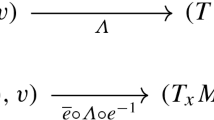Abstract
Bargmann’s superselection rule, which forbids the existence of superpositions of states with different mass and, therefore, implies the impossibility of describing unstable particles in non-relativistic quantum mechanics, arises as a consequence of demanding Galilean covariance of Schrödinger’s equation. However, the usual Galilean transformations inadequately describe the symmetries of non-relativistic quantum mechanics since they can produce phases in the wavefunction which are relativistic time contraction remnants and therefore, cannot be physically interpreted within the theory. In this paper we review the incompatibility between Bargmann’s rule and Lorentz transformations in the low-velocities limit, we analyze its classical origin and we show that the Extended Galilei group characterizes better the symmetries of the theory. Furthermore, we claim that a proper description of non-relativistic quantum mechanics requires a modification of the notion of spacetime in the corresponding limit, which is noticeable only for quantum particles.
Similar content being viewed by others
Notes
The author thanks an anonymous referee for referring to these papers.
As it is well known, Galilean transformations leave the line elements dt 2 and d x 2 invariant, separately. The “metric” η μν introduced here corresponds to the dominant temporal part only, and the fact that Galilean transformations do not mix spatial and temporal coordinates is contained in its degeneracy.
It transforms properly not only the coordinates but the momentum and energy as well, cf. (24).
An action of a connected Lie group on a symplectic manifold is called a Poisson action if the Hamiltonian functions H a (where a is an element of the corresponding Lie algebra) for one-parameter groups are single-valued, and chosen so that the Hamiltonian function depends linearly on elements of the Lie algebra and so that the Hamiltonian function of a commutator is equal to the Poisson bracket of the Hamiltonian functions:
$$H_{[a,b]}=\{H_a,H_b\}, $$see Ref. [16], p. 372.
The author thanks an anonymous referee for bringing to his attention this remark.
The author thanks an anonymous referee for bringing to his attention this fact.
Notice that in the non-relativistic limit, quantum states ψ are such that |P ψ|≪mc|ψ| and therefore \(|H\psi|=mc^{2}|\psi|+\mathcal{O}(c^{0})\), that is, while H can generate non-relativistic time translations even for time intervals of \(\mathcal{O}(1/c^{2})\), P produces non-relativistic spatial translations only for spatial intervals of order c 0. And consequently a quantum particle can only keep track of corrections of order 1/c 2 in the time coordinate.
References
de Azcárraga, J.A., Izquierdo, J.M.: Lie Groups, Lie Algebras, Cohomology Groups and Some Applications in Physics. Cambridge University Press, New York (1995)
Levy-Leblond, J.-M.: Galilei group and non relativistic quantum mechanics. J. Math. Phys. 4, 776 (1963)
Anandan, J.: Sagnac effect in relativistic and nonrelativistic physics. Phys. Rev. D 24, 338 (1981)
Bargmann, V.: On unitary group representations of continuous groups. Ann. Math. 59, 1 (1954)
Greenberger, D.M.: Inadequacy of the usual Galilean transformation in quantum mechanics. Phys. Rev. Lett. 87, 100405 (2001)
Greenberger, D.M.: arXiv:1011.3719 [quant-ph] (2010)
Greenberger, D.M.: Theory of particles with variable mass. I. Formalism. J. Math. Phys. 11, 2329 (1970)
Greenberger, D.M.: Theory of particles with variable mass. II. Some physical consequence. J. Math. Phys. 11, 2341 (1970)
Greenberger, D.M.: Some useful properties of a theory of variable mass particles. J. Math. Phys. 15, 395 (1974)
Greenberger, D.M.: Wavepackets for particles of indefinite mass. J. Math. Phys. 15, 406 (1974)
Giulini, D.: On Galilei invariance in quantum mechanics and the Bargmann superselection rule. Ann. Phys. 249, 222–235 (1996)
Mashhoon, B.: Quantum theory in accelerated frames of reference. In: Ehlers, J., Lämmerzahl, C. (eds.) Special Relativity. Lect. Notes Phys., vol. 702. Springer, Berlin (2006)
Holland, P., Brown, H.R.: The Galilean covariance of quantum mechanics in the case of external fields. Am. J. Phys. 67, 204 (1999)
Greenberger, D.M.: The neutron interferometer as a device for illustrating the strange behavior of quantum systems. Rev. Mod. Phys. 55, 875–905 (1983)
Matthews, P.T., Salam, A.: Relativistic field theory of unstable particles. Phys. Rev. 112, 283–287 (1958)
Arnold, V.I.: Mathematical Methods of Classical Mechanics. Springer, New York (1989)
Dieks, D.: A quantum mechanical twin paradox. Found. Phys. Lett. 3, 347 (1990)
Colella, R., Overhauser, A.W., Werner, S.A.: Observation of gravitationally induced quantum interference. Phys. Rev. Lett. 34, 1472–1474 (1975)
Werner, S.A., Staudenmann, J.-L., Colella, R.: Effect of Earth’s rotation on the quantum mechanical phase of the neutron. Phys. Rev. Lett. 42, 1103–1106 (1979)
de Montigny, M., Khanna, F.C., Santana, A.E.: Lorentz-like covariant equations of non-relativistic fluids. J. Phys. A, Math. Gen. 36, 2009 (2003)
Greenberger, D.M., Overhauser, A.W.: Coherence effects in neutron diffraction and gravity experiments. Rev. Mod. Phys. 51, 43 (1979)
Acknowledgements
It is a pleasure to thank C. Chryssomalakos, E. Okon, D. Sudarsky and Y. Bonder for helpful discussions. This work has been partially supported by the Czech Ministry of Education, Youth and Sports within the project LC06002.
Author information
Authors and Affiliations
Corresponding author
Rights and permissions
About this article
Cite this article
Hernandez-Coronado, H. From Bargmann’s Superselection Rule to Quantum Newtonian Spacetime. Found Phys 42, 1350–1364 (2012). https://doi.org/10.1007/s10701-012-9673-5
Received:
Accepted:
Published:
Issue Date:
DOI: https://doi.org/10.1007/s10701-012-9673-5



